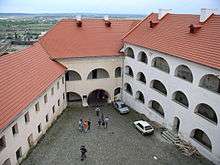Palanok Castle
Coordinates: 48°25′53″N 22°41′16″E / 48.431507°N 22.687798°E
| Palanok Castle | |
|---|---|
| Mukachevo, Zakarpattia Oblast, Ukraine | |
|
The Palanok Castle. | |
| Type | Castle |
| Site information | |
| Condition | Survives in good condition; some parts in disrepair. |
| Site history | |
| Built | 14th century |
The Palanok Castle or Mukachevo Castle (Ukrainian: Замок "Паланок", translit. Zamok "Palanok"; Hungarian: Munkács vára, Munkácsi vár) is a historic castle in the city of Mukacheve in the western Ukrainian oblast (province) of Zakarpattia. The Palanok Castle is delicately preserved,[1] and is located on a former 68 metre high volcanic hill. The castle complex consists of three parts: the high, middle, and low castle.[2]
The founding cornerstone for the castle was laid sometime in the 14th century by the members of the Hungarian noble family Aba and was an important fortification of the Kingdom of Hungary throughout the centuries. The castle was later transformed into an impregnable fortress by French engineers. After the storming of the Bastille, a famous French prison, the Palanok Castle was used as an all-European political prison.[1] Through the centuries, the castle served as a residence to many people: the Koriatovych family for almost 200 years,[3] the Serbian prince Đurađ Branković, Regent of Hungary János Hunyadi, and the wife of a Hungarian king, Laiosh Maria, among many others.[1]
During the ownership of Prince Fedir Koriatovych, the castle became one of the most protected castles in the region. The prince and his family lived in the highest part of the castle, which had lavishly decorated interiors. Francis II Rákóczi later used the castle as the centre of a war of independence led by himself. In 1726, Charles VI, Holy Roman Emperor, granted Palanok Castle with Mukacheve, Chynadiyovo and 200 villages to Elector Lothar Franz von Schönborn who had elected and crowned him and was one of his main political supporters within the Empire. The estate, one of the largest in Eastern Europe, remained in the family well into the 20th century. From 1796 to 1897, Palanok Castle was used as a prison. During 1805–1806, the Crown of St. Stephen was kept within the castle to protect it from Napoleon I's troops. In 1926, the castle was used as a barracks, and later as an agricultural college.
At the time of the castle's height, it had a strong protection: 164 cannons of varying sizes and 60 barrels of gunpowder.[3] The castle was also surrounded by a deep moat, surrounded by high wooden walls, to protect the castle from invaders.
The total area of the castle is 14,000 m². The castle consists of 130 different rooms with a complex system of underground passages connecting them together. The castle currently houses a museum dedicated to the history of Mukachevo and the castle.
 View of the Palanok Castle hill.
View of the Palanok Castle hill. Although some parts of the castle are currently being rebuilt, other parts are still in disrepair.
Although some parts of the castle are currently being rebuilt, other parts are still in disrepair. An interior courtyard of the castle, seen with modern roofs.
An interior courtyard of the castle, seen with modern roofs. Closer shot of the clock tower.
Closer shot of the clock tower.
References
- 1 2 3 myukraine.info — Mukachevsky "Palanok" Castle
- ↑ ukrainainkognita.org.ua — Mukachevskyi zamok "Palanok" Part 1
- 1 2 castles.org — Mukachevo Castle
External links
| Wikimedia Commons has media related to Palanok castle. |
- palanok.org.ua — Site Mukachevskyi zamok "Palanok" dedicated to the Palanok Castle (Ukrainian)
- ukrainainkognita.org.ua — Mukachevskyi zamok "Palanok" Part 1 and Part 2 (Russian)
- city.mukachevo.net — Zamok "Palanok" (Ukrainian)
- karpataljaturizmus.net — Palanok Castie (Munkácsi vár) (Hungarian)
- Magyar Nemzeti Bank — Commemorative coin "Munkács Castle"
